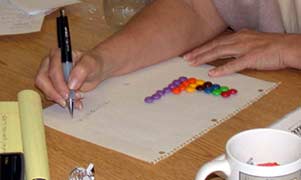|
|
return to
|
|||||||||||||||||||||||||||||||||||||||||||||||||||||||||||||||||||||||||||||||||
The Importance of Variation
3. Variation and Genetic Drift |
||||||||||||||||||||||||||||||||||||||||||||||||||||||||||||||||||||||||||||||||||
|
Begin with a pitcher of M&Ms illustrating color variation:
Randomly pour some into cups and have each team calculate the number (and frequency) of each color in their population sample:
Note that although purple was the dominant color (highest frequency) in the parent population, this is no longer the case in three of the subset populations. (Dominant color shaded for each group.) If you have only a small portion of a population, the frequency is often skewed and over time, the population will continue to move in a direction where the frequency increasingly varies from the parent population. This is referred to as Founders Effect and it is often found on islands where a small number of individuals form the start of a new population. In other words, evolution (change in frequencies) does not have to occur only with strong selection as we saw in the previous activity. Evolution can also be greatly influenced by the starting population, especially if that starting population is small. |
||||||||||||||||||||||||||||||||||||||||||||||||||||||||||||||||||||||||||||||||||
More on Variation:
|
||||||||||||||||||||||||||||||||||||||||||||||||||||||||||||||||||||||||||||||||||
|
Return to: Lines of Evidence for Past Change | Dynamic Earth Homepage | UCMP Homepege |
||||||||||||||||||||||||||||||||||||||||||||||||||||||||||||||||||||||||||||||||||

